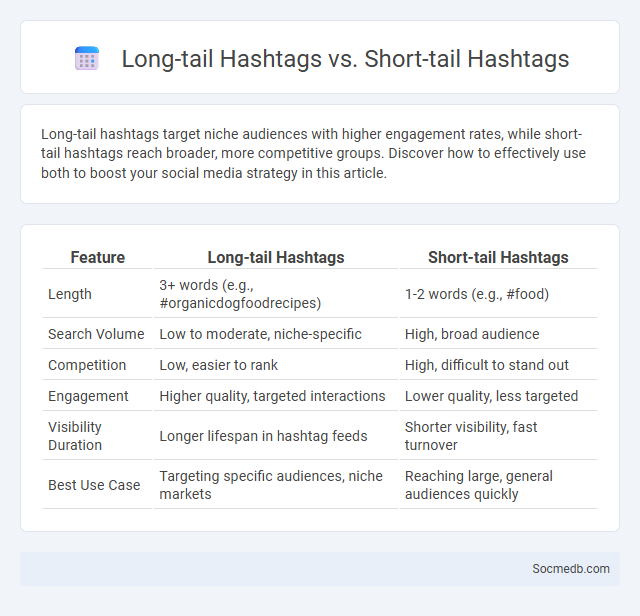
Photo illustration: Long-tail Hashtags vs Short-tail Hashtags
Long-tail hashtags target niche audiences with higher engagement rates, while short-tail hashtags reach broader, more competitive groups. Discover how to effectively use both to boost your social media strategy in this article.
Table of Comparison
| Feature | Long-tail Hashtags | Short-tail Hashtags |
|---|---|---|
| Length | 3+ words (e.g., #organicdogfoodrecipes) | 1-2 words (e.g., #food) |
| Search Volume | Low to moderate, niche-specific | High, broad audience |
| Competition | Low, easier to rank | High, difficult to stand out |
| Engagement | Higher quality, targeted interactions | Lower quality, less targeted |
| Visibility Duration | Longer lifespan in hashtag feeds | Shorter visibility, fast turnover |
| Best Use Case | Targeting specific audiences, niche markets | Reaching large, general audiences quickly |
Introduction to Hashtag Types
Hashtags are essential tools on social media platforms that categorize content and increase visibility by connecting posts to specific topics or trends. Common hashtag types include branded hashtags, which promote companies or campaigns, trending hashtags that highlight popular or timely events, and community hashtags used to engage niche audiences or interest groups. Understanding these distinct hashtag types enables marketers and users to strategically enhance reach, foster engagement, and improve content discoverability across social media networks.
What Are Long-tail Hashtags?
Long-tail hashtags are highly specific and niche keyword phrases used on social media platforms to target a more focused audience, often consisting of three or more words. These hashtags improve content visibility by reducing competition and increasing the likelihood of engagement from users interested in particular topics. Utilizing long-tail hashtags helps brands and creators connect with communities seeking specialized information or interests, leading to more meaningful interactions.
What Are Short-tail Hashtags?
Short-tail hashtags are broad, popular keywords consisting of one or two words used widely across social media platforms to reach a large audience quickly. These hashtags, such as #Travel or #Fitness, generate high search volumes but face intense competition, making it challenging for individual posts to stand out. Using short-tail hashtags strategically can help your content gain immediate visibility, though pairing them with niche-specific hashtags often improves engagement and discoverability.
Key Differences Between Long-tail and Short-tail Hashtags
Short-tail hashtags consist of one or two generic words with high search volume, offering broad reach but fierce competition, while long-tail hashtags are longer, more specific phrases targeting niche audiences and resulting in higher engagement rates. You can increase your social media visibility by strategically combining short-tail hashtags for awareness and long-tail hashtags for targeted interaction. Understanding the key differences in hashtag length, specificity, and competition helps optimize your content discovery and audience growth.
Advantages of Using Long-tail Hashtags
Long-tail hashtags on social media enhance content discoverability by targeting specific niche audiences, which increases engagement rates and follower growth. These hashtags face less competition, allowing posts to maintain visibility longer and reach a more relevant user base. Utilizing long-tail hashtags also improves SEO by aligning content with precise search queries, boosting organic reach and driving higher-quality traffic.
Pros and Cons of Short-tail Hashtags
Short-tail hashtags, typically one to two words long, increase content visibility by reaching a broad audience and enhancing discoverability across social media platforms. However, their high popularity often results in intense competition, making it challenging for posts to stand out and achieve sustained engagement. Overuse of generic short-tail hashtags can also lead to lower content relevance and potential audience disengagement.
Building a Balanced Hashtag Strategy
Building a balanced hashtag strategy involves combining popular, niche, and branded hashtags to maximize reach and engagement on social media platforms. Analyzing your audience's behavior and trending topics ensures your hashtags remain relevant and effective in increasing visibility. You can enhance your content's discoverability and foster a community by strategically selecting and rotating hashtags tailored to your brand's goals.
Best Practices for Effective Hashtag Usage
Using relevant and specific hashtags increases your content's visibility and engagement by targeting niche audiences interested in your topic. You should limit hashtags to around 5-10 per post to avoid appearing spammy while maximizing reach. Research trending and industry-specific hashtags to ensure your content aligns with popular conversations and attracts the right followers.
Common Mistakes in Hashtag Campaigns
Many social media hashtag campaigns fail due to poor research, resulting in irrelevant or overused tags that dilute your message and reduce engagement. Ignoring the platform-specific hashtag trends and character limits often leads to lower visibility and interaction rates. Ensuring your hashtags are unique, targeted, and concise helps increase reach and strengthens your brand presence.
Conclusion: Optimizing Your Hashtag Strategy
Optimizing your hashtag strategy significantly boosts social media engagement and reach by targeting relevant audiences and trending topics. Leveraging analytics tools to monitor hashtag performance enables data-driven adjustments that enhance visibility and follower growth. Consistently using a mix of popular, niche, and branded hashtags maximizes content discoverability across platforms like Instagram, Twitter, and TikTok.
 socmedb.com
socmedb.com